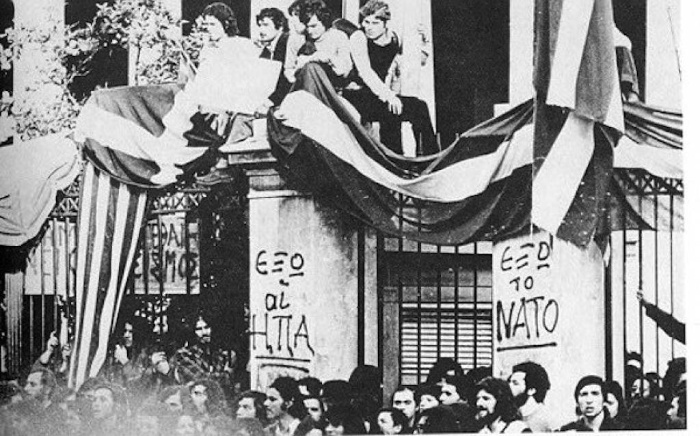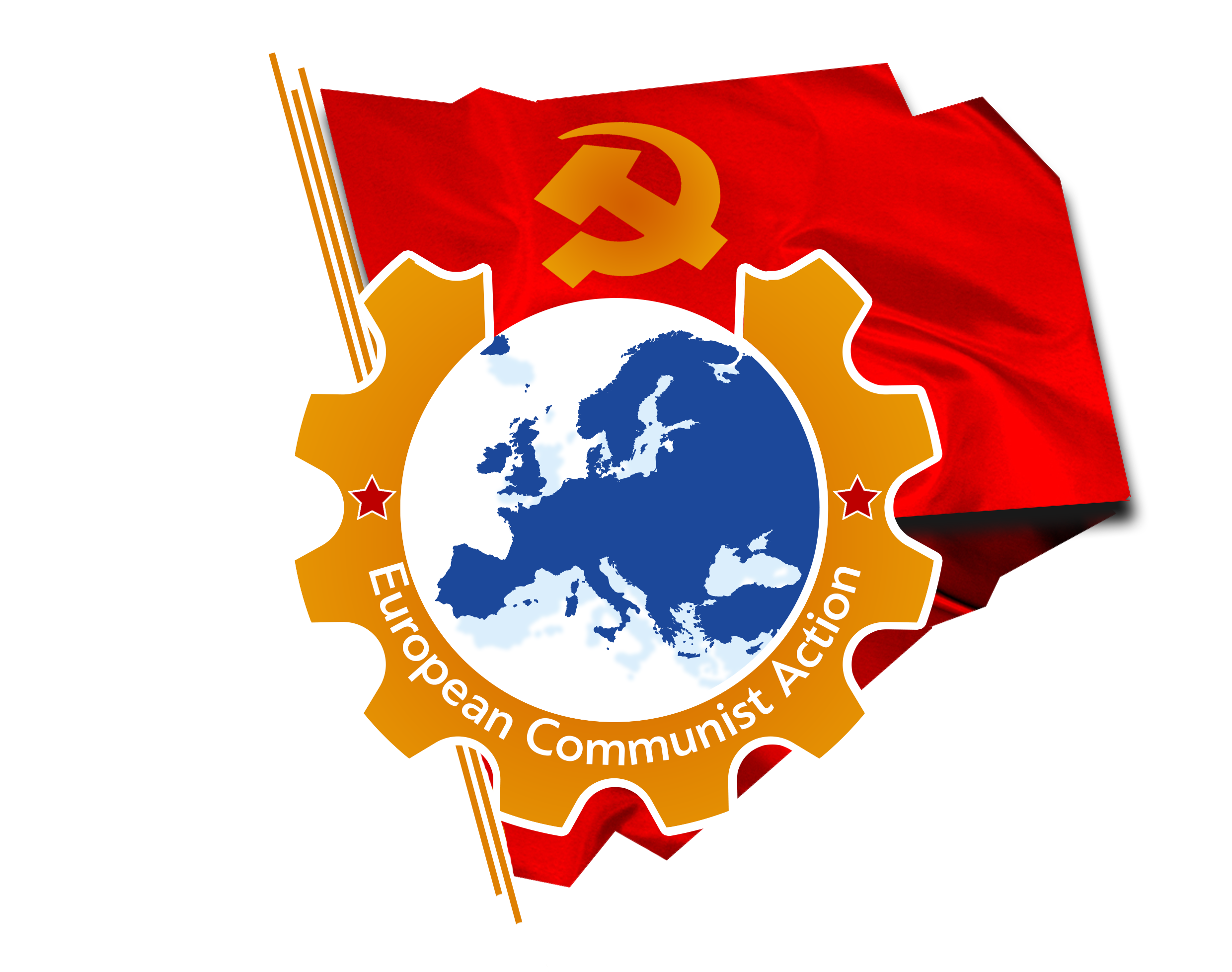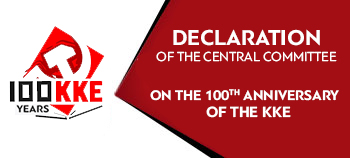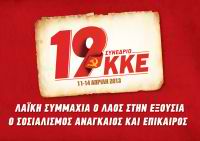Links to the old web pages of KKE
A brief review of the Polytechnic uprising

On the night of the 20th to the 21st of April 1967, the reactionary military circles of the country, which were closely connected to the secret services of the USA and NATO, conducted a military coup. The operation of the surrender of power to the army had been developed at the staff of NATO, under the code name "Prometheus". Colonels G. Papadopoulos and N. Makarezos, who were actively involved in the preparation of the coup, became known as "the black colonels". During the fascist occupation 1940-44, several of these officers participated in the security forces and the mopping'up operations against communists; some of them even worked with Gestapo and were later connected to the secret services of the English and Americans. The military junta, headed by G. Papadopoulos, N. Makarezos and the generals S. Pattakos and G. Zoitakis, having planed a conspiracy with the king and based on the article 91of the Constitution of Greece, published a decree stating the transition of all of the power to the army and the abolition of a series of articles of the Constitution, concerning democratic rights.
Having seized the power, the military dictatorship proceeded with the materialisation of the "Prometheus" operation. Every democratic liberty in the country had been abolished, a marshal law had been imposed, strikes and meetings were banned, harsh censorship was introduced, political parties and progressive social organizations were also banned. The army took upon it extensive authority, arrests and searches had been conducted. By the order of the dictatorship, thousands of political and social fighters of our country were arrested, first and foremost cadres of the Communist Party of Greece (KKE) and the legal, until then, political party, United Democratic Left (EDA), through which, communists also fought. According to statements by the officials of the dictatorial regime, more than 40 thousand communists had been arrested till the May of 1967.
In order to deceive people, the colonels named their coup "national revolution", which was supposed to have been conducted "for the benefit of all the classes of the Greek society". The army and especially the officers, were declared "driving force of the revolution", and the struggle against communism had been set as the main goal.
The coup became possible in Greece, because the military forces of the country were under the strict control of the reaction. The labour and democratic movement had not still reorganized its forces after the defeat in the civil war of 1946-1949. The development of the mass movement in Greece was impeded by the emergency laws, which first of all prohibited the action of KKE. The leaders of the "Centre Union" Party followed a policy of fragmentation of the democratic forces, disintegrating any common stance of the opposition, aiming at the repulse of the reaction, thus enforcing it. The opportunist elements that existed inside KKE during that period had succeeded in 1958 a decision to be taken for the dissolution of the illegal party organizations, to be taken, supposing that KKE, could, at the end, allegedly be replaced by a wider structure of the Left, EDA. EDA, despite its' high election results, up to 28%, not only failed to develop a true alternative, but even failed to prepare the party forces and the popular movement before the coup.
The regime of the 21st of April of 1967 was an overt terrorist military-fascist dictatorship of the domestic and foreign monopolies. A characteristic particularity of the military-fascist regime has been no other than the close involvement of the American imperialism, in the preparation and the establishing of the dictatorship.
The anti-dictatorship struggle
Straight after the coup, KKE strengthened its' struggle for the rallying of all of the democratic and patriotic organizations. It summoned all the patriots, despite their party belonging, at factories, neighbourhoods, villages, universities, schools and state institutions, to organize in resistance committees, in order to overthrow the fascist dictatorship. On the initiative of KKE and EDA, the Patriotic Anti-dictatorship Front (PAM) had been formed on the May of 1967. Later, other anti-junta organizations made their appearance, such as PAK and the "Democratic Defence".
KKE at deep illegality and in spite of the blows it had endured not only from junta, but also from the opportunists who had split the party in 1968, managed to regroup the party organizations, created the "Unified Trade Union Anti-dictatorship Movement" (ESAK) and set up its' youth organization, the Communist Youth of Greece (KNE), which was going to play an avant-garde role in the Polytechnic uprising in 1973.
The uprising of the Polytechnion
The sharpening of the socio-economic contradictions in Greece and the rise of the anti-dictatorship movement, in 1973, lead to the deep crisis of the regime. The dissatisfaction grew even in the army, the regime's main support.
In the mid of 1973, the demonstrations of the workers embraced one branch of the economy after the other. One federation after the other gave notice of termination of their collective contracts and demanded a 45-50% rise in their salaries. These mobilizations were characterised by the vivacity and unity of workers, independently of their political beliefs and lead to the isolation of juntas' people in the trade union movement.
The struggle of the university and technological institutions students was an important parameter of the political developments in Greece, especially in 1973. Their main demands were the progressive reforms in the educational system, the restoration of trade union, academic and political liberties. The students of Athens, Thessalonica, Patra, Ioannina, conducted meetings, assemblies, demonstrations with slogans such as: "Democracy", "Down with fascism", "Down with the dictatorship", "One is the leader, the sovereign people", "Freedom to the political prisoners".
Because of the worsening of the financial standing of the poor peasantry, mass manifestations started to break out through the whole of Greece, and took the form of refusal of handing the goods over to the trade. The solidarity with the political prisoners and their families' movement, aiming at the release of the political prisoners, also developed.
In order to diminish the pressure towards the regime, the military dictatorship, Papadopoulos went on to remove several of their collaborators from the government and to form a "political" government headed by the leader of the 'Progressive Party' S. Markezinis. The main task of the new government (October 8 1973) was to prepare 'parliamentary elections'.
The political manoeuvres of Papadopoulos did not lead to the stabilization of the situation the in the country. The anti-government manifestations persisted. It is worth mentioning that the opportunist fraction that split from the party in 1968 and created the eurocommunist 'KKE-interior' supported the manoeuvre of 'politization' of the dictatorial regime. A top moment had been the uprising of the students of the Polytechnic University of Athens and of the young workers of Athens, on the 14-17 November 1973, which gave the final blow to the attempts to disguise the regime. The main slogans of the uprising were: 'Bread, Education, Liberty', 'National Independence', 'Down with Papadopoulos', 'Out the Americans and NATO' e.t.c. Large masses of workers supported the students and the young workers. The students' mobilizations acquired the form of university building occupations, in Thessalonica and Patra. Demonstrations had also been organized in Trikala and Drama.
In Athens, the students managed to create a radio station and inform people from the building of Polytechnic of the mass manifestations. KNE in Athens and the Anti-dictatorship Students' Union (Anti-EFEE), played a special role in the organization of the struggle.
On the 17th of November, at night, tanks had been thrown at the revolted students and workers. At that night, 56 people were killed, according to official records. According to police records, 1103 citizens and 61 policemen had been injured. As it became known after the fall of the dictatorship, 34.000 bullets had been used by the police, in addition to the 300.000 cartridges of all kinds, used by the army, so as to repress the revolt. In the days of the revolt, the regime went on to arrest 2.500 people, although it announced merely the arrest of 866, having made the following presentation of their social status: 475 workers, 268 students, 74 pupils, 49 Polytechnic students.
Although the revolt had been drowned in blood, the overall reaction to the regime grew. Eight months later (24 July 1974), the dictatorship fell under the weight of its treason and adventurism in Cyprus, where the coup, that it had organized in cooperation with the secret services of NATO, aiming at the extermination of the progressive regime of President Makarios (15/7/1974) led to the Turkish invasion and occupation of the 37% of Cyprus.
Then, mass demonstrations against the dictatorship had been held in a lot of cities of Greece. The pressure of the masses had been so great that the Greek oligarchy, decided to remove junta and to hand the power over to a coalition of bourgeois parties, in which right-conservative elements persisted, in order to avoid the worst. This coalition had been but an expression of the compromise among the junta supporters, the imperialist circles of NATO and USA, as well as of the bourgeois political powers of Greece, for the 'legal' handing over of the power to the latter.
At the same time, and without waiting for the release and return of the comrades in exile and from abroad, the illegal organizations of KNE and KKE regained legality. The legal activity of KKE had been won de facto and the circulation of the daily party's newspaper 'Rizospastis' began. The new bourgeois government was forced to abolish the anti-communist law 509, through which the political activity of KKE had been prohibited for whole decades, since 1947.
Each year, activities are held in honour of the students and workers, who revolted in the November of 1973. The culminating moment of these annual manifestations is the demonstration to the US embassy on 17th of November.







